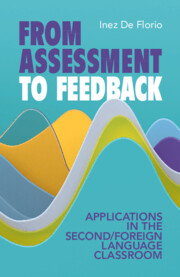Book contents
- From Assessment to Feedback
- From Assessment to Feedback
- Copyright page
- Contents
- TEFL Examples
- Introduction
- Part I Basic Concepts of Assessment and Feedback in the Foreign-Language Classroom
- 1 Feedback in Everyday Life and in Foreign-Language Education
- 2 Different Forms of Assessment and Feedback in Language Teaching and Learning
- 3 Evidence-Based or at Least Science-Oriented Research
- 4 The Evolution of Education and Foreign-Language Teaching as a Prerequisite of Feedback
- Part II Assessment and Feedback in Its Different Manifestations
- Part III Summative Assessment in Combination with Formative Feedback
- Glossary
- References
1 - Feedback in Everyday Life and in Foreign-Language Education
from Part I - Basic Concepts of Assessment and Feedback in the Foreign-Language Classroom
Published online by Cambridge University Press: 19 January 2023
- From Assessment to Feedback
- From Assessment to Feedback
- Copyright page
- Contents
- TEFL Examples
- Introduction
- Part I Basic Concepts of Assessment and Feedback in the Foreign-Language Classroom
- 1 Feedback in Everyday Life and in Foreign-Language Education
- 2 Different Forms of Assessment and Feedback in Language Teaching and Learning
- 3 Evidence-Based or at Least Science-Oriented Research
- 4 The Evolution of Education and Foreign-Language Teaching as a Prerequisite of Feedback
- Part II Assessment and Feedback in Its Different Manifestations
- Part III Summative Assessment in Combination with Formative Feedback
- Glossary
- References
Summary
Feedback in everday communication is compared to assessment and feedback practices in the school context. Whereas feedback in real life is mostly used to clarify misunderstandings, there is a great variety of applications in the teaching and learning context. Feedback in schools should start with positive aspects of the learner’s performance and include valuable advice to improve learning. Feedback in schools in Western countries like the United States, Canada, and European countries apart, certain general rules differ a great deal because the expectations of teachers and learners are quite different. Furthermore, the possibilities to have face-to-face contact with speakers whose mother tongue is the foreign language learned by a student are very limited. Last but not least, the role of the teacher can vary a great deal, and teaching and learning strategies along with it. As examples, foreign language education in China and in Japan is described.
Keywords
- Type
- Chapter
- Information
- From Assessment to FeedbackApplications in the Second/Foreign Language Classroom, pp. 7 - 17Publisher: Cambridge University PressPrint publication year: 2023



